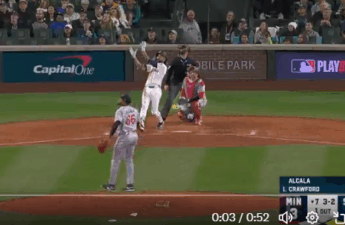
Turns out my Facebook feed is the exception. No one is voting in the United States. According to the New York Times, the elections earlier this month set a 72-year low for voter turnout, with 36.3% voting. (For context, Catalonia’s recent non-binding independence vote was widely disregarded as totally irrelevant because it garnered only 41.6% turnout.) The NYT excoriated this turnout in its Veteran’s Day editorial, concluding somewhat baselessly that “The reasons are apathy, anger and frustration at the relentlessly negative tone of the campaigns.”
Now I agree that the turnout is appallingly low. However, blaming negative ads is only a small part of the picture as to why voting seems utterly irrelevant to people these days. The much larger issue, which may be what they mean by “apathy [and] anger”, is that there are no real choices being offered in the elections. The two major parties are increasingly indistinguishable and care about their own careers and self-preservation far more than any sort of issue or agenda. And most people have been beaten into the belief that third-parties are irrelevant and a waste. So you know what saves you from all this frustration? Just not voting.
After all, as a Princeton study concluded earlier this year, the United States is no longer really a democracy. For all our self-aggrandizing hype about the principles this country was founded on, we no longer adhere to anything like a recognizable government of the people. So-called “special interests” are really the only interests that lawmakers find relevant and the only policies worth pursuing for all but a tiny handful are those which pave the path to further re-election.
There are manifold and complex proofs available of this reality. I already discussed last week how the referenda that passed in red states demonstrate a far more progressive electorate than is reflected in the Republican landslide. But most people are not thinking about going to the polls to support state-wide initiatives, so turnout remains low. Although, while the NYT editorial tries to draw a link between ballot access (e.g. vote-by-mail and other turnout-improving efforts) and turnout, there seems to be a stronger link between major initiatives and turnout.
Only seven states (Maine, Wisconsin, Alaska, Colorado, Oregon, Minnesota, and Iowa) had turnout over 50%. Of them, three had huge, widely publicized statewide ballot initiatives. Oregon was voting on marijuana legalization (plus six other referenda), Colorado on a so-called personhood amendment (plus three other referenda), and Alaska on both marijuana and raising the minimum wage (plus an additional referendum). Maine had seven initiative referenda on the ballot, although six of them were standard-issue bonds and one was about (no kidding) bear hunting. Wisconsin had just one question, about creating a transportation fund. And, admittedly, the last two, Minnesota and Iowa had no referenda.
But South Dakota (10th in turnout, 44.6%) had 3 referenda, including the minimum wage question. North Dakota (12th, 44.1%) had 8 and Louisiana (13th, 43.9%) a whopping 14. Meanwhile, the seven states in turnout below 30% (Indiana, Texas, Utah, New York, Tennessee, Mississippi, and Oklahoma) averaged 2.1 referenda each, below the national average of 2.9. And none of them were particularly major or significant.
There’s certainly some correlation here, but I’ll admit it’s not an open-and-shut case. After all, there’s Minnesota and Iowa near the top of the charts with no referenda, plus New Hampshire (11th, 48.8%) with 0. Major referenda will definitely bring people out to the polls, but it doesn’t seem to be the only driver of voting interest. So what’s going on in these other states?
Let’s start with Maine, because it’s at the top of the charts. And while, yes, bear hunting is a pivotal issue and bond issues are always popular, the seven referenda here are a little weak in content compared to the hefty measures passed by Alaska and Oregon. Well the additional thing that stands out about Maine is that 8.4% of its gubernatorial vote went to an Independent, third only to Alaska (3rd, 55.3%, 3 referenda) and Wyoming (27th, 39.1%, 1 referendum), who split 8.6% of the vote among two third-party candidates. Alaska elected an Independent as Governor with 48.1%; an additional 5.5% went to even fringier Independent candidates. 4.7% went Independent in Colorado’s Governor race, 5.5% in Oregon, 5.4% in Minnesota, and 3.6% in Iowa.
Among those voting for Senate as well, the numbers are high for third-parties and Independents in the high-turnout states as well. While Maine didn’t have any third-party candidates, Alaska went 5.6% third-party, Colorado 5.5%, Oregon 6.8%, Minnesota 3.9%, and Iowa 4.1%. So there seems to be a decent correlation between strong independent voting and turnout, especially where it’s combined with referenda.
The big exceptions to this that stand out are Wisconsin (2nd, 56.9%, 1 referendum) and New Hampshire. Wisconsin notched just 1.2% for two third-party candidates in the gubernatorial race and didn’t run a Senate campaign. Granted, Wisconsin’s Governor race was perhaps the most talked-about in the nation with embattled and controversial incumbent Scott Walker defending his office. And New Hampshire had 0% for third parties (do they ban them from running in the general election?) in both their Governor and Senate races. But to be fair, they had both of those races and among the closest races across the nation in both, with the margins of each election below 5%. So their turnout seems explicable, if not following reasons for high turnout in other states. After all, Indiana (50th, 28.0%) had no state-wide offices on the ballot, nor any referenda.
So people like statewide referenda on major issues, they like third parties, and they like close races that seem to matter. Which helps explain why turnout is so low when the main thing we get to vote on every two years is our local representative in the 435-seat House of Representatives. This is the body that composes half of Congress, which is running at around 11% popularity in this country. And yet 96.4% of House incumbents were re-elected.
There was even a meme about this:

Politifact fact-checked this on Veteran’s Day (apparently that was the day to do political analysis this year) and found the claims largely true, even if Congress’ approval ratings might have surged to 14% just before the election. The re-election rate in the House appears to be even higher, at 96.6%.
This points to a well-known phenomenon that everyone hates the House in general, but kind of loves their representative. Something that I just learned has been dubbed Fenno’s paradox, for the original coiner in 1978. The main reason for this, obviously, is intensely gerrymandered districts that are shaped like all manner of absurdity in order to make safe districts for the major parties. These districts destroy voter interest because it’s a foregone conclusion who will win, incidentally making it easier for corporations in those districts to give to only one candidate because they know who’ll take the race. And in the two-party-or-bust belief structure, Democratic districts still like checking the D-box and Republican districts the R-box. After all, straight-party voting is still a literal time-saving checkbox in many states.
A secondary reason well below gerrymandering probably has to do with pork-barreling, that people remember the project that their Congressperson brought home to their district, like a manufacturing contract or a military base. This of course relies on the idea that voters are paying attention to the fine print of Congressional bills which is not bloody likely. But admittedly this is probably part of a re-election flyer that some House members mail out using their free-mail privilege from DC, so it probably influences some people.
Confoundingly, this is the New York Times’ solution in the wake of all this information about disastrously low turnout:
Showing up at the polls is the best way to counter the oversized influence of wealthy special interests, who dominate politics as never before. But to encourage participation, politicians need to stop suppressing the vote, make the process of voting as easy as possible, and run campaigns that stand for something.
The first sentence is one of the most willfully unaware statements I have ever read in American print. Yes, wealthy special interests dominate politics as never before. But what on Earth is showing up going to do to combat that? Unless an army of non-voters decide to show up and all support the same third-party candidate, no amount of voting is going to overturn special interests’ chokehold on American government. Both parties have been bought and paid for. Special interests donate extensively to both parties. If you show up to the polls with the intent to beat back special interests and then pull the lever for either a Democrat or a Republican, you’re just kidding yourself.
The second sentence is more tolerable, if a bit trite. Yes, voter suppression (by definition) lowers turnout. And making voting easier is a good idea, though we’re still a long way from people making Election Day a national holiday or anything like that which would actually help. But there’s something really insidious in that last part of the sentence. “campaigns that stand for something.” This is not the problem. Barack Obama’s 2008 campaign stood for all sorts of things (and, notably, drove voter turnout way up). But his Presidency has stood for the exact opposite, most notably in continuing and expanding the most draconian of Bush militarism and deportation. So I guess the NYT is kind of right, that campaigns that make claims get people in the voting booth. But that seems like less than half the battle. The issue is having politicians who make their time in office stand for something, and that something being beyond what special interests want.
I don’t really think anything can save the American “democracy” at this point, realistically, which is why I think most people aren’t voting. But if you want to make recommendations for what will help, it seems more efforts at direct democracy through ballot initiatives that bypass elected officials are good. Stronger third-party candidates that people take seriously are good (can’t stress enough that Maine and Alaska were #1 and #3 in turnout, both above 55%, and both had their gubernatorial vote swung [or won] by an Independent). And making races close and contested helps.
There’s really not much point in increasing ballot access if the only people they’re going to vote for are the same major party candidates that have already been bought by a power with much more influence than the mere voter.


